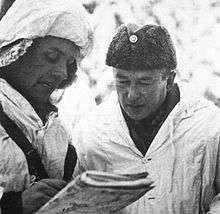Hjalmar Siilasvuo
Hjalmar Fridolf Siilasvuo (born Hjalmar Fridolf Strömberg, 18 March 1892, Helsinki – 11 January 1947) was a Finnish lieutenant general who led troops in the Winter War, Continuation War and Lapland War. He also saw action as a part of the Finnish volunteer "Jägerbattalion 27" fighting on the German side in World War I.
Hjalmar Siilasvuo | |
|---|---|
 Hjalmar Siilasvuo (at right) receiving a situation report of Battle of Raate-Road | |
| Born | 18 March 1892 Helsinki, Grand Duchy of Finland, Russian Empire |
| Died | 11 January 1947 (aged 54) Oulu, Finland |
| Buried | |
| Allegiance | |
| Service/ |
|
| Years of service | 1915–1947 |
| Rank | Gruppenführer (Germany, 1916) Lieutenant General (Finland, 1940) |
| Commands held | Brigade Siilasvuo (Winter War) III Corps (1941–1942 and 1944) Group Lapland (1944) I Division (1944–1947) |
| Battles/wars | Finnish Civil War
|
| Awards | Iron Cross Order of the White Rose Order of the Cross of Liberty Mannerheim Cross |
| Other work | Writings, Municipal Council |
Biography
The son of a newspaper editor, Siilasvuo had studied law, and been involved with politics in the Ministry of Education. He was an officer in the Jäger Battalion in Germany during World War I, and later became a battalion commander during the Finnish Civil War. He was opinionated, but a cunning military commander.
Siilasvuo was a colonel whom Mannerheim assigned to lead JR-27, Finnish troops sent to oppose two Red Army divisions, the 163rd and 44th, at Suomussalmi during the Winter War. Siilasvuo fought the 163rd division, fully aware that if the 163rd and 44th ever met up, it would be all over for the defenders of Suomussalmi. While fighting the 163rd division, Siilasvuo sent troops to take advantage of the terrain the slow moving 44th was using to pin the division, so they could go no further. The 44th were a crack division, but their expertise was fast-moving mechanised warfare, and the terrain meant they had to leave their heavier equipment behind and go slowly with what they had. The unit had plenty of skis but few in the division could ski. After dealing with the 163rd mottis, the Finns looted weapons and equipment and used them to attack the pinned 44th. Even though they were tired from destroying the 163rd, the division's spoils immediately raised morale amongst the troops, convincing them they could finish the 44th from two directions - north and south.
From the 163rd and 44th divisions, the Finnish soldiers captured 85 tanks, 437 trucks, 1,620 horses, 52 cannons, 40 field artillery, 78 anti-tank guns, 20 tractors, 13 AA guns, over 6,000 rifles and an enormous amount of ammunition. The Soviet High Command executed a number of generals for this loss. Afterwards, Siilasvuo was sent to the Kuhmo sector to deal with the Red Army's 54th division. Upon arrival with all the new weaponry, Siilasvuo ordered an artillery barrage of 3,200 rounds, something unheard of in the Finnish forces during the Winter War. Siilasvuo's men pinned the 54th, but it survived until the peace, although according to Siilasvuo the Finns would have won had the fight gone on for just a couple of days longer. With his record in the Winter War, Siilasvuo was promoted to general.
During the Continuation War he led the III Corps which was attached to the command of the German Army of Norway (Wehrmacht) since 15 June 1941 to participate in the Operation Silver Fox, which was launched on 1 June 1941, after that it was moved to Karelian Isthmus in 1944.
After the armistice with the Soviets, he was given the command of the Finnish forces fighting the Germans in Lapland.
He was awarded the Mannerheim Cross on 21 December 1944.
His son Ensio Siilasvuo was also a general in the Finnish army.
External links
![]()